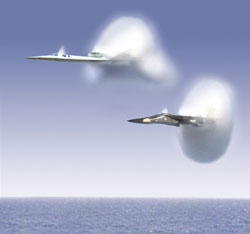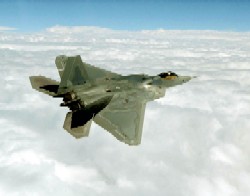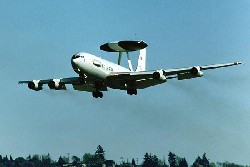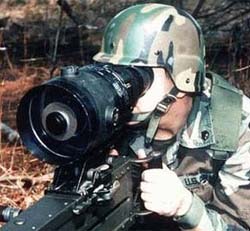Daily News
by Gail Helmer
[ Send Us News | Archives ]
Northrop Grumman Corporation's Integrated Systems Sector (ISS) will perform the first flight demonstration of a sonic boom mitigated by airframe shaping as part of a cooperative industry and government effort under the Defense Advanced Research Projects Agency's (DARPA) Quiet Supersonic Platform (QSP) program.
The flight test will use a Northrop Grumman F-5E aircraft with a modified forward fuselage to produce a specially shaped sonic boom that is expected to be noticeably quieter than a conventional sonic boom produced minutes earlier by an unmodified F-5E. This "back-to-back" test approach is intended to highlight the effect that aircraft shaping can have on the mitigation of sonic booms.

Artist's concept of the plume of a "shaped" sonic boom (left) compared to the plume of a conventional boom (right).
The flight demonstration work, expected to be completed by September 2002, will involve all government and industry QSP participants because it is considered a key overall program enabler and risk-reducer.
DARPA's QSP program is designed to lay the foundation for efficient and capable long-range supersonic cruise aircraft that will operate with a less intense sonic boom and reduced takeoff and landing noise. The QSP program is focused on the validation of multiple breakthrough technologies to enable such an aircraft. DARPA awarded multiple initial contracts last year to industry, government laboratories and universities.
Northrop Grumman will perform the F-5E shaped sonic boom demonstration under a cooperative agreement with DARPA valued at approximately $3 million. The award complements Northrop Grumman's existing QSP contract of $2.5 million for system integration studies and technology development that was awarded in October 2000.
F-22 Programme Exceeds Congressional Limit
The troubled Lockheed Martin F-22 "Raptor" fighter programme has run into more difficulties as current estimations predict that production is set to exceed the $37.6 billion limit imposed by Congress. Separate estimates carried out by the US Air Force and Defence Secretary Donald Rumsfeld's Office in December 2000 have both found that production of the 333 aircraft currently scheduled to be built will take programme costs beyond that mark.

Air Force cost estimators project that, as things stand, the programme will overspend by $2 billion, while the Office of the Secretary suggests that the figure will be nearer $9 billion. If this second figure is correct it would mean that the US Government would need to build 85 fewer F-22's in order to stay within the financial boundaries set by Congress. Both reports were part of projections to support the budget request for the 2002 fiscal year.
Already Lockheed Martin, which is developing the F-22 to replace the F-15 fighter, are thought to need approximately $550 million more than the Congressional allowance to complete the development phase. The contractor and the Air Force have worked upon plans to reduce production costs throughout the programme for an estimated saving of $26.5 billion. However, with the spectre of President George W.Bush's vastly expensive missile defence plans likely to intensify the scrutiny of defence spending in Washington, the Department of Defence can ill afford this programme to run over budget.
Boeing NATO AWACS Upgrade Starts
Boeing has received a $24 million production long-lead contract to continue the modernisation of the NATO Airborne Warning and Control System (AWACS) fleet. This contract award protects the production schedule for the fleet of 17 NATO AWACS aircraft. One aircraft, modified as part of an engineering, manufacturing and development contract under the NATO Mid-Term Modernisation Program, is undergoing flight testing. The rest of the fleet will be upgraded under a production and retrofit contract expected to be awarded in 2002.

Steve Behnen, Boeing NATO AWACS programme manager, said, "This contract allows us to put production processes in place with our subcontractors and order long lead time parts."
Under the Mid-Term Modernisation Program, Boeing is integrating major upgrades to the computers, displays, communications, navigation and target identification. The enhancements include:
Raytheon has delivered the 3,000th AN/PAS-13 Thermal Weapon Sight (TWS) to the US Army. Developed by Raytheon Tactical Systems, Dallas, and the US Army, TWS is an advanced thermal weapon sight that combines rugged, lightweight construction with superior thermal imaging technology. It incorporates wide and narrow fields of view, electronic zoom capability, and contains electronically programmable reticles that provide compatibility with a broad range of weapons.

The Army accepted the milestone delivery in July 2001 as part of the Thermal Omnibus I procurement of products. Awards to date under the Thermal Omnibus I contract total $96 million for the variants of the TWS, with options existing to provide an additional 9,000 units during the next two years.
"The delivery of the 3,000th TWS is a result of Raytheon's commitment to teamwork with the Army, providing US light forces with the most technologically advanced thermal weapon sights available today," commented Colin Schottlaender, vice president and general manager of Tactical Systems.
[ Send Us News | Archives ]
by Gail Helmer
Friday August 03, 2001
- Northrop Grumman To Demonstrate Less Intense Sonic Boom
- F-22 Programme Exceeds Congressional Limit
- Boeing NATO AWACS Upgrade Starts
- Raytheon Delivers 3000th Thermal Weapon Sight
- Jane's News Briefs
Military News
Northrop Grumman To Demonstrate Less Intense Sonic BoomNorthrop Grumman Corporation's Integrated Systems Sector (ISS) will perform the first flight demonstration of a sonic boom mitigated by airframe shaping as part of a cooperative industry and government effort under the Defense Advanced Research Projects Agency's (DARPA) Quiet Supersonic Platform (QSP) program.
The flight test will use a Northrop Grumman F-5E aircraft with a modified forward fuselage to produce a specially shaped sonic boom that is expected to be noticeably quieter than a conventional sonic boom produced minutes earlier by an unmodified F-5E. This "back-to-back" test approach is intended to highlight the effect that aircraft shaping can have on the mitigation of sonic booms.

The flight demonstration work, expected to be completed by September 2002, will involve all government and industry QSP participants because it is considered a key overall program enabler and risk-reducer.
DARPA's QSP program is designed to lay the foundation for efficient and capable long-range supersonic cruise aircraft that will operate with a less intense sonic boom and reduced takeoff and landing noise. The QSP program is focused on the validation of multiple breakthrough technologies to enable such an aircraft. DARPA awarded multiple initial contracts last year to industry, government laboratories and universities.
Northrop Grumman will perform the F-5E shaped sonic boom demonstration under a cooperative agreement with DARPA valued at approximately $3 million. The award complements Northrop Grumman's existing QSP contract of $2.5 million for system integration studies and technology development that was awarded in October 2000.
F-22 Programme Exceeds Congressional Limit
The troubled Lockheed Martin F-22 "Raptor" fighter programme has run into more difficulties as current estimations predict that production is set to exceed the $37.6 billion limit imposed by Congress. Separate estimates carried out by the US Air Force and Defence Secretary Donald Rumsfeld's Office in December 2000 have both found that production of the 333 aircraft currently scheduled to be built will take programme costs beyond that mark.

Air Force cost estimators project that, as things stand, the programme will overspend by $2 billion, while the Office of the Secretary suggests that the figure will be nearer $9 billion. If this second figure is correct it would mean that the US Government would need to build 85 fewer F-22's in order to stay within the financial boundaries set by Congress. Both reports were part of projections to support the budget request for the 2002 fiscal year.
Already Lockheed Martin, which is developing the F-22 to replace the F-15 fighter, are thought to need approximately $550 million more than the Congressional allowance to complete the development phase. The contractor and the Air Force have worked upon plans to reduce production costs throughout the programme for an estimated saving of $26.5 billion. However, with the spectre of President George W.Bush's vastly expensive missile defence plans likely to intensify the scrutiny of defence spending in Washington, the Department of Defence can ill afford this programme to run over budget.
Boeing NATO AWACS Upgrade Starts
Boeing has received a $24 million production long-lead contract to continue the modernisation of the NATO Airborne Warning and Control System (AWACS) fleet. This contract award protects the production schedule for the fleet of 17 NATO AWACS aircraft. One aircraft, modified as part of an engineering, manufacturing and development contract under the NATO Mid-Term Modernisation Program, is undergoing flight testing. The rest of the fleet will be upgraded under a production and retrofit contract expected to be awarded in 2002.

Steve Behnen, Boeing NATO AWACS programme manager, said, "This contract allows us to put production processes in place with our subcontractors and order long lead time parts."
Under the Mid-Term Modernisation Program, Boeing is integrating major upgrades to the computers, displays, communications, navigation and target identification. The enhancements include:
- Flat panel situation displays with a Windows-like environment to support the interaction between operators and sensor systems increasing the operator's situational awareness.
- A new mission computing system implementing advanced Multi-Sensor Integration which will improve the reliability and accuracy of target tracking and identification, automated recording and replay of mission data, and an open-system architecture supporting cost-effective future upgrades to hardware and software.
- Digital communications systems to improve crew management and use of radio links.
- Satellite communications will be integrated into the mission system for over-the-horizon communications links.
- Broad-spectrum VHF radios will support improved interoperability with Eastern European nations' air and ground forces.
- Improved Identification Friend or Foe (IFF) interrogators and transponders that will be compatible with emerging international air traffic control systems requirements.
- Upgraded aircraft navigation that takes advantage of the new Global Positioning System.
Raytheon has delivered the 3,000th AN/PAS-13 Thermal Weapon Sight (TWS) to the US Army. Developed by Raytheon Tactical Systems, Dallas, and the US Army, TWS is an advanced thermal weapon sight that combines rugged, lightweight construction with superior thermal imaging technology. It incorporates wide and narrow fields of view, electronic zoom capability, and contains electronically programmable reticles that provide compatibility with a broad range of weapons.

The Army accepted the milestone delivery in July 2001 as part of the Thermal Omnibus I procurement of products. Awards to date under the Thermal Omnibus I contract total $96 million for the variants of the TWS, with options existing to provide an additional 9,000 units during the next two years.
"The delivery of the 3,000th TWS is a result of Raytheon's commitment to teamwork with the Army, providing US light forces with the most technologically advanced thermal weapon sights available today," commented Colin Schottlaender, vice president and general manager of Tactical Systems.
